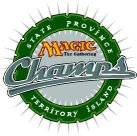The 2004 Championship Deck Challenge: Down and Dirty G/R
 Welcome to Red Week!
Welcome to Red Week!
This week is going to be fantastic. As you can see from today’s star spangled front page, we picked up Dan Paskins (and yet another National Champion in playtesting partner John Ormerod) for this project. When I started work on the Championship Deck Challenge, I crossed my fingers and hoped that Dan would sign up for the inclusion of basic Mountain and here he is. Dan will be discussing his Red deck early next week, but today I’m here to give you the results of my testing – a fresh G/R deck that tried to bridge the gaps between beating Affinity and Tooth and Nail.

